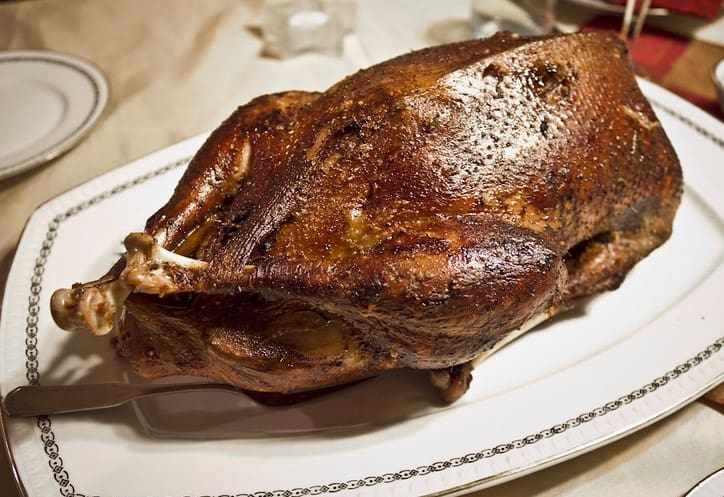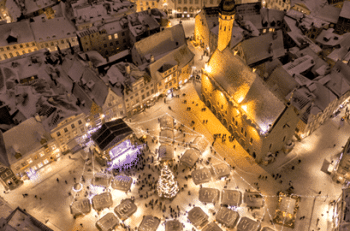When it comes to Christmas dinner, the centrepiece roast is a tradition that brings families together in celebration. While turkey has long been the go-to choice for many, there are lots of people in the UK who enjoy a more unique and flavourful option: goose.
However, goose has a rich, gamey taste that sets it apart from other poultry options. The meat is tender, succulent and full of flavour, making it a real treat for the taste buds. It is also a more expensive Christmas dinner meat than traditional offerings such as turkey.
Here, the Christmas.co.uk team will guide you through the process of buying and cooking a goose for your Christmas feast, including tips on what to look for.
Why goose has been a perennial favourite for Christmas dinner
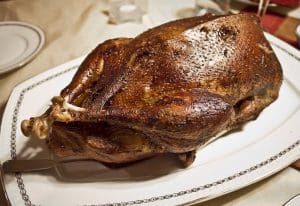
Indeed, British families opted for goose until the 1950s when turkey became much cheaper and popular.
The history of cooking a goose for Christmas is very interesting – did you know that a goose is a solar bird, meaning that it follows the cycle of the sun and reaches its peak of fatness and flavour around midwinter?
This made it an ideal choice for celebrating the winter solstice, a pagan festival that marked the shortest day of the year and the return of longer days.
When Christianity arrived in Britain, the solstice celebrations were incorporated into the new religion, and the goose became associated with Christmas as well.
Practical choice for farmers
Goose was also a practical choice for farmers, who could let their geese roam freely over the fields after the harvest and feed on fallen grains, fallen apples and other natural foods.
This gave the meat a rich and complex taste that was highly valued. The original free-range meat!
Goose was also a source of other benefits, such as eggs, feathers, down, quills and fat – with the fat being used for cooking and for lighting and medicinal purposes.
It remains, however, a particular favourite at Christmas for goose fat to be used in creating crispy, roast potatoes.
The most popular poultry for Christmas dinner
Goose remained the most popular poultry for Christmas dinner throughout the medieval and Tudor periods, when it was often served with elaborate sauces and accompaniments.
Henry VIII is said to have been the first English king to eat turkey at Christmas, but goose remained more common among the masses.
Even in Victorian times, when farming methods improved and made turkey more affordable, goose still held its place on many festive tables.
Indeed, Charles Dickens famously described a Christmas goose in A Christmas Carol, when Scrooge sends one to the Cratchit family as a gesture of generosity.
People appreciate its unique flavour and texture
In recent years, goose has enjoyed a revival as more people appreciate its unique flavour and texture, as well as its natural and ethical rearing methods.
British geese are usually free-range and pasture-fed, which makes them healthier and happier than factory-farmed birds.
They are also more sustainable, as they require less feed and water than turkeys or chickens.
According to British Goose Producers, around 250,000 geese are sold in the UK each year for Christmas, compared to 10 million turkeys.
However, demand often outstrips supply, so it is advisable to order your goose well in advance if you want to secure one.
Where to buy a goose in the UK at Christmas
While roast goose is a classic centrepiece for a traditional Christmas dinner, it’s not a bird that you will see stocked in most supermarkets.
However, if you are wanting to goose, they are easy to buy – and we have linked to a helpful site from the British Poultry Council that you simply enter where you live, and the map will display nearby stockists.
Whether you choose to buy from your local butcher, farmers’ market, online retailer or a supermarket, there are plenty of options available to suit your preferences and budget.
Don’t forget to consider factors like size, quality and sourcing when making your choice, and be sure to place your order well in advance to guarantee a festive feast that your loved ones will remember for years to come.
Local butchers
One of the best places to start your search for a Christmas goose is your local butcher. Butchers often stock high-quality meats, and many will have geese available during the festivities. Visiting your local butcher not only supports small businesses but also allows you to ask for recommendations and cooking tips from experienced professionals. Don’t forget to place your order well in advance, as Christmas geese tend to be in high demand.
Farmers’ markets
Farmers’ markets are another excellent source for sourcing a fresh Christmas goose. Many local farmers sell their poultry at these markets, and you can often find free-range or organic options that are ideal for a traditional feast. It’s a good idea to check with the market’s schedule and the participating vendors in advance to ensure you don’t miss out. You can use this Farmers UK site to find a market near you.
Online retailers
In today’s digital age, online retailers offer a convenient way to buy a Christmas goose. Numerous websites specialise in delivering quality meats right to your doorstep. Sites such as Farm2Fork offer a wide range of poultry options, including geese. When purchasing online, make sure to check delivery times and conditions, as Christmas can be a busy period for couriers.
Local farms
If there isn’t a farmers’ market being held near you, do a quick Google search to find local farms about buying a goose for your Christmas dinner. Lots of farms raise geese and sell them to the public. By buying directly from the farm, you can often ensure that your goose is locally sourced and of the highest quality. Some farms may even allow you to visit and choose your goose in person.
We mentioned using the British Poultry Council website to find a goose supplier and found this is a useful set-up. And if you can’t visit, many of the suppliers will happily post a goose to your home.
Supermarkets
Most major supermarkets in the UK, such as Sainsbury’s and Waitrose, stock Christmas geese during the Christmas season. While supermarket options may not always be as specialised as those from local butchers or farms, they are convenient and readily available. Be sure to check the label for information on the goose’s origin and quality.
Remember to pre-order a goose for Christmas
Regardless of where you decide to buy your Christmas goose, it’s crucial to plan ahead and pre-order. Geese can be limited in supply during the festivities, so securing your bird early ensures that you won’t be left empty-handed on Christmas Day.
What to look for when buying a goose
Choosing the perfect goose for your Christmas dinner is essential to ensure a succulent and flavoursome meal. Here are some key factors to consider when buying one:
- British: Choose a fresh British goose, if possible, as they are generally superior in quality and flavour. Frozen goose is available all year round, but fresh goose is in season from the end of September until January.
- Freshness: Look for a goose that is fresh and plump, with no unpleasant odours. Buying from reputable butchers or local farms to ensure better quality.
- Colour: Look for even-coloured, off-white skin with no signs of bruising or damage.
- Size: Consider the number of guests you’ll be serving. A general guideline is to allow about 1kg (2.2 lbs) of uncooked weight per person.
- Oven: Check the weight of the goose and make sure it will fit in your oven. A 5kg goose will feed at least five people – and up to eight. You can also buy goose crowns or legs separately if you prefer.
- Quality: Opt for a free-range or organic goose if possible. These birds have been raised in a more natural and humane environment, resulting in better flavour.
oooOooo
Gordon Ramsay – Spiced Christmas goose
If you think goose for Christmas dinner is boring, here’s Gordon Ramsay with his spiced goose recipe to change your mind.
It may be an old clip, but Gordon shows how creative a goose can be for a festive meal choice.
He says this is a treat and the trick is to get the fat out of the bird before dishing up.
As a nice alternative to turkey, the process of creating an impressive goose is straightforward.
Even we have to admit, the finished result looks tasty – and might be on our own Christmas dinner tables this year!
oooOooo
How to prepare a goose for Christmas dinner
While goose is a popular choice at Christmas, it’s worth checking out these instructions if you have never prepared or cooked one before.
- Remove all the fat from inside the bird and save it for later (Check out the Waitrose video below on how to roast a goose – the chef pulls big chunks of fat from the bird!). You can render it down slowly over a low heat, then strain and store it in the fridge for up to six months. Goose fat is great for frying or roasting vegetables, especially potatoes.
- Remove the giblets from inside the bird and use them to make stock for gravy or stuffing. The liver can be used to make pâté or pan-fried and eaten on toast.
- Prick the skin all over with a small knife or skewer, especially around the legs and under the wings. This will help the fat to drain out during roasting and make the skin crispier.
- Stuff the cavity with aromatics such as orange halves, bay leaves, rosemary sprigs, onion quarters, garlic cloves, or anything else you like. You can also make a separate stuffing to serve alongside the goose, but don’t overfill the bird as it will affect the cooking time.
oooOooo
The perfect roast goose recipe for Christmas
We really enjoyed this offering from chef Aaron Middleton because he offers a few extra steps in the preparation of goose that other chefs leave out.
And it looks like the effort put into the preparation really pays off!
This recipe for goose is for the more accomplished chef since Aaron removes the wings and wishbone using a boning knife.
He then scores the skin and rubs in a lot of salt before putting the bird in the oven.
To help deliver the flavours, he mixes honey and spices into a thick paste and brushes it onto the bird for the final cooking.
He uses a meat thermometer to check the temperature, adds more glaze and then cooks and rests it.
The result is impressive and worthwhile for any ambitious chefs out there!
If you want a simpler recipe for roasting a goose at Christmas, then check out Rick Stein’s offering below.
oooOooo
How to roast a goose
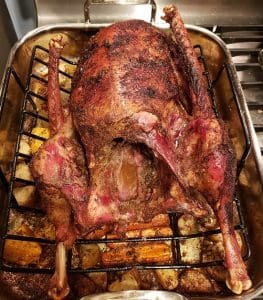
For the best results, goose benefits from slow cooking at a moderate temperature.
- Preheat your oven to 200°C/180°C fan/gas 6 and place a rack over a large roasting tin
- Rub the goose all over with rapeseed oil or melted butter and season well with salt and pepper
It’s worth noting that many chefs will add an orange or apple that has been pricked to allow flavours and steam to escape in the cavity.
- Place the goose on the rack, breast-side up, and cover loosely with foil
- Roast for about 30 minutes per kg, basting occasionally with the juices in the tin
- Remove the foil for the last hour of cooking to let the skin brown and crisp up
You can also add some root vegetables such as carrots, parsnips or celeriac to the tin to roast in the goose fat.
- To check if the goose is cooked, insert a skewer into the thickest part of the leg. The juices should run clear, and the meat should be tender. You can also use a meat thermometer to check that the core temperature is 70°C.
- Transfer the goose to a carving board and let it rest for at least 30 minutes before carving. This will help the meat retain its juices and make it easier to slice.
Follow the natural lines of the bird when carving, separating the leg and breast meat for easy serving.
oooOooo
Waitrose: How to roast a goose
Chef Jon Jones from the Waitrose Cookery School shows how to roast a goose – and he makes it look really easy.
From removing the giblets and fat, adding a sprinkling of salt into the cavity and placing the stuffing in the neck end, this is a great step by step video.
Also, not many people will appreciate the tip of placing the stuffing in the neck of the bird, but it will, Jon says, help regulate the temperature in the bird when cooking.
He then uses pre-soaked skewers to hold the skin together, adds more seasoning, and it’s then ready for the oven!
Again, there is goose fat available for cooking crisp roast potatoes.
Cooking times vary so check the cooking instructions that come with your goose.
oooOooo
How to carve a roast goose
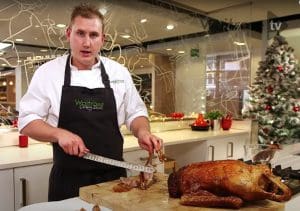
However, carving a roast goose can be a bit tricky if you don’t know the right technique.
Here, we show you how to carve a roast goose like a professional:
- Let the goose rest. After roasting the goose, you should let it rest for at least 20 minutes before carving. This will allow the juices to redistribute and the meat to become more tender and moist.
- Remove the legs and wings (if you haven’t already done so).
- Place the goose on a large cutting board. Use a sharp knife to cut through the skin and joint between the leg and the body. Repeat with the other leg. Then, cut through the wing joints and remove the wings. You can serve the legs and wings whole or cut them into smaller pieces
- Cut off the breast meat. To remove the breast meat, you need to locate the breastbone, which runs along the centre of the goose. Use your knife to make a cut along one side of the breastbone, following the curve of the rib cage. Then, slice the breast meat across the grain into thin slices. Repeat with the other side of the breastbone
- Serve and enjoy. Transfer the carved meat to a large platter and serve with your favourite side dishes and sauces.
We think that a video showing you how to carve a goose properly is also worth watching.
Here is chef Jon Jones from Waitrose – pictured above – showing how it should be done.
He makes clear that the aim is to get as much meat as possible off the bird and how you should present the carved meat.
It’s also noticeable that he keeps the skin on, and he shows how to remove and present the sausage meat stuffing used in this bird.
Enjoy!
oooOooo
Making gravy for a roast goose dinner
There are lots of recipes for making a gravy for your roast goose dinner but here’s one we found to be easy to make – with great results.
- After cooking your goose, skim off most of the fat from the roasting tin and reserve it for later use. You should have around 250ml of juices left in the tin – You should read our article on why a gravy separator is a good investment.
- Place the tin over a medium-high heat on the hob (or transfer the juices to a pan if your roasting tin isn’t designed for hob top use) and sprinkle over some plain flour
- Stir the mix well and gradually whisk in some hot stock made from the giblets or from a good-quality cube or pot. You can also add some wine or cider (highly recommended!) for extra flavour
- Bring the gravy to a boil and let it simmer until slightly thickened. Season to taste with salt, pepper and any herbs or spices you like
- Strain the gravy through a sieve into a warmed jug and serve with the carved goose.
oooOooo
Rick Stein’s roast goose with stuffing and apple sauce
We’ve looked at how to cook a goose with varying amounts of effort, and here popular chef Rick Stein wows with a simple offering.
This is another Waitrose creation so if you want a quality goose at Christmas it’s probably worth starting your search in one of their stores.
Rick says he has switched to cooking with goose at Christmas because of the better flavours.
He takes a bird, trusses it and puts it onto a rack and places it into a moderate oven.
While it is cooking, he makes a gravy using the giblets with bacon. He also adds the neck and gizzards.
Plus, he keeps the fat to one side for his roast potatoes.
He adds veg to create an excellent, tasty stock.
Rick also makes a simple stuffing and checks the temperature of the bird before resting.
To make the gravy he uses the fat in the pan adds flour, and the stock to deglaze the pan for the gravy.
The result is a mouth-watering dish that everyone at the Christmas dinner table will love!
oooOooo
What vegetables to serve with a roast goose at Christmas
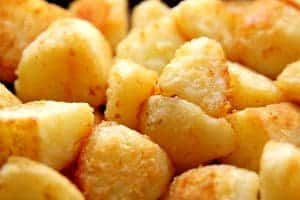
This is also an opportunity to try out new ideas and since red cabbage is the traditional choice, you could start there.
Alternatively, this rich and succulent meat will benefit from any of these ideas:
- Brussels sprouts: A classic Christmas vegetable, they pair nicely with the fatty goose. You can roast them in the oven with some bacon, chestnuts or garlic for extra flavour and crunch
- Red cabbage: Another cabbage variety that works well with goose is red cabbage, which has a sweet and tangy taste. You can cook it slowly on the stove with some apple, vinegar, sugar and spices until it becomes soft and caramelised
- Roast potatoes: No roast dinner is complete without some crispy roast potatoes, and they are especially delicious with goose fat. You can parboil them first, then toss them in some hot goose fat and season with salt, pepper and rosemary. Roast them in a hot oven until golden and crunchy
- Parsnips: Parsnips are a root vegetable that have a sweet and nutty flavour. They also roast well in goose fat, or you can mash them with some butter, cream and nutmeg for a creamy side dish
- Carrots: Another root vegetable that adds colour and sweetness to your plate is carrot. You can roast them whole or cut into chunks, or you can glaze them with some honey, butter and orange juice for a sticky and glossy finish
- Bread sauce: Bread sauce is a traditional sauce made from breadcrumbs, milk, butter, onion, cloves, bay leaf and nutmeg. It has a thick and creamy texture and a mild flavour that complements the goose. You can make it ahead of time and reheat it before serving
- Cranberry sauce: Cranberry sauce is a fruity and tangy sauce that adds some contrast to the rich goose. You can make your own by simmering fresh or frozen cranberries with some sugar, water, orange zest and cinnamon, or you can use a good quality product from a jar.
- Alternative Christmas goose sauces: We think it is worth checking out Delia Smith who has some novel ideas about what alternative sauces could be used. There is a tasty prunes in Armagnac creation which uses 350g of no-soak prunes, 50g of sugar and 150ml of Armagnac – though in the original recipe Delia uses one pint of cold black tea. Sounds odd but it works really well. You could also use Delia’s Cumberland sauce which is redcurrant creation and served cold. She uses red currant jelly, a lemon and an orange, port, mustard and ground ginger. Both work well with goose.
Of course, you can also add your own favourites or try something new.
The Christmas.co.uk team have put together some ideas for unusual Christmas dinner side dishes to enjoy.

